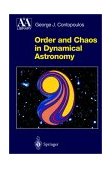 |
Order and Chaos in Dynamical Astronomy
G. Contopoulos, Astronomy and Astrophysics Library, Springer-Verlag (2002) Institute of Physics Publ. (2002), 624 pages, price €70 + VAT. |
| Reviewer: Carles Simó, Department of Mathematics, Universitat de Barcelona, Spain. |
The book is divided in three parts, devoted to: (1) Order and chaos in general, (2) Order and chaos in galaxies and (3) Other applications in Dynamical Astronomy.
The author is a well-known scientist who has been involved in research in Dynamical Astronomy and Dynamics of galaxies for the last 50 years. He has produced a big number of papers and is responsible for the existence of a large community working in these topics and closely related areas in Greece. The amount of work done is impressive, and the present Volume can be considered as a summary of ideas and numerical results obtained by the author and collaborators. But not as an updated
state of the art.
The author states that the book is addressed to: (i) Astronomers studying problems of Dynamical Astronomy; (ii) Persons interested in dynamics in general which want to know how astronomers deal with their problems.
The reviewer s opinion is that the book reflects how
some astronomers deal with various problems. The reader can find information on integrable systems, normal forms, KAM and Nekhorosev theories, periodic orbits, transitions to chaos, different ways to measure the amount of chaos, many examples of Hamiltonian systems with two degrees of freedom, some examples with three or more degrees of freedom, galactic models and their orbits, chaos in the solar system and small excursions into chaos in relativity and cosmology. This is an impressive list of topics. But the treatment given in the book mainly considers simple examples. Many of the Hamiltonian systems of the concrete models given in the book are either low degree polynomials or trigonometric polynomials. A total of 305 figures is presented, a large part of them showing families of periodic orbits. The computation of periodic orbits, their stability and bifurcations is used as a key tool in most of the book. This is certainly a good tool for systems with two degrees of freedom, but nothing is said about how to compute invariant tori, their stability properties and the related invariant manifolds in the case of normally (partly) hyperbolic tori, which are relevant for larger number of degrees of freedom.
It should not be considered at all as a mathematical book (the author clearly states this already in the Preface) but rather as a book mainly based on heuristic considerations based on numerical experiments (without too many details on how these experiments are done). The reader should not expect any deep analysis nor clear ideas about the interplay between different points of view (dynamics, geometry, problems of convergence or careful numerical analysis). The analytic parts of the text are presented at a formal level. The reviewer has the feeling that the book can be dangerous in the hands of inexperienced students. Indeed, several definitions are rough or incomplete and some claims are not justified. Statements like "zero maximal Lyapunov exponent implies that the motion is ordered (in opposition to ergodic)" (p. 254), "in general nothing will change fundamentally by the addition of higher order terms to a polynomial potential in the case of two degrees of freedom" (p. 46) or "two nearby orbits deviate exponentially fast in case of sensitive dependence" (p. 14), just to mention a few examples, should be taken with caution. At some places there is a mix up of ideas between phase space and configuration space, the existence of global Poincaré sections is not discussed, some compactness requirements seem to be not necessary, and the reader is never sure about the regularity of the functions used. Furthermore there appear some sections devoted to non-Hamiltonian systems (e.g. the logistic map and the dissipative Hénon map) which show behavior far away from the Hamiltonian case. This can be confusing for the reader.
A very positive point, which is duly stressed, is the fact that most of the real systems and even very simplified models of them, are away from ordered and from chaotic. This is presented as "divided phase space". For moderate perturbations of an integrable Hamiltonian with two degrees of freedom this can be approximately accepted. But for more degrees of freedom both regimes are mixed in a complicated way.
Summarizing: The book can be interesting as a source of information and for the heuristic discussions following the presentation of several concrete problems in Astronomy.